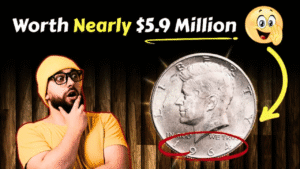Imagine paying for coffee and getting a $2 bill in change. You might shove it in your wallet, but what if it’s worth millions? A rare 1976 $2 bill sold for $2.349 million at a 2025 auction, making collectors and casual spenders alike check their cash. These bills could be hiding in your pocket or a dusty drawer. This guide dives into the history, what makes these bills so valuable, and how you can spot a jackpot-worthy $2 bill.
The Unique Charm of the $2 Bill
A Quirky Piece of American History
The $2 bill first appeared in 1862 but never became a daily staple like $1 or $5 bills. Today, it features Thomas Jefferson on the front and the signing of the Declaration of Independence on the back. Its rarity in circulation makes finding one feel like a small victory.
Why People Love It
The $2 bill has a cult following for its oddity. Collectors cherish its historical vibe, while others keep them as lucky charms. Though still printed, they’re uncommon, adding to their allure.
The 1976 Bicentennial Bill: A Collector’s Dream
A Special Release
In 1976, the U.S. Mint reissued the $2 bill to celebrate America’s 200th birthday. Released on April 13—Thomas Jefferson’s birthday—these bills were a hit. Many were saved as keepsakes, keeping them in pristine condition.
The Million-Dollar Find
A 1976 $2 bill with a low serial number and a printing error sold for $2.349 million in 2025. Only a few exist with these rare traits, like single-digit serials or misaligned seals. These factors make them a holy grail for collectors.
What Makes a $2 Bill So Valuable?
Key Factors Driving Value
Rarity, condition, and unique features determine a $2 bill’s worth. The 1976 series is prized for its Bicentennial tie and limited special prints. Here’s what sets the valuable ones apart:
| Feature | Common $2 Bill | Rare 1976 $2 Bill |
|---|---|---|
| Year | Any year | 1976 Bicentennial |
| Serial Number | Standard | Low (e.g., 00000001) or repeater |
| Condition | Circulated, worn | Crisp, uncirculated |
| Printing Errors | None | Misaligned seals or ink |
| Star Note | No | Yes (star in serial) |
The Role of Condition
Bills are graded on a 1–70 scale by services like PCGS or NGC. A “gem uncirculated” (65+) bill fetches top dollar. Even slight creases can drop the value significantly.
How to Spot a Valuable $2 Bill
Simple Steps to Check Your Bill
You don’t need to be an expert to find a treasure. Follow these steps:
- Check the Year: Look for 1976 on the front.
- Inspect the Serial Number: Low numbers (like 00000001) or patterns (e.g., 12341234) are valuable.
- Look for a Star: A star (*) in the serial number means it’s a rare replacement note.
- Examine Condition: Crisp, uncreased bills are worth more.
- Spot Errors: Misaligned printing or ink smudges can boost value.
Tools You’ll Need
- A magnifying glass to check serial numbers and errors.
- A coin collecting guide or app for reference.
- Access to a grading service for authentication.
Where to Look
Check change from stores, gas stations, or vending machines. Old wallets, family heirlooms, or bank rolls are prime spots. Handle potential finds gently to preserve value.
Are These $2 Bills Still Out There?
Still in Circulation
Since $2 bills are legal tender, they could appear anywhere. Stories of people finding valuable ones in cash registers or old envelopes keep the hunt alive. Millions of $2 bills are still out there, and a rare one could be yours.
Real-Life Jackpots
In 2023, a man found a 1976 star note in a diner’s change, later valued at $10,000. Another collector discovered a low-serial-number bill in a family safe, selling it for $500,000. These tales show the potential is real.
Other Valuable $2 Bills to Watch For
Beyond 1976
While the 1976 series steals the spotlight, other $2 bills can be valuable:
- 1928 Red Seal: Early series, worth $100–$4,500 in good condition.
- 1953 Star Notes: Replacement notes, often $50–$500.
- 1963 Low Serials: Rare prints can fetch hundreds.
- Repeater Serials: Patterns like 45454545 can hit $10,000+.
Special Features
Look for “radar” serials (e.g., 12344321, reads the same backward) or “ladder” serials (e.g., 12345678). These can add thousands to a bill’s value.
Tips for Protecting and Selling Your $2 Bill
Preserve Its Value
Don’t fold or clean the bill—handling can lower its grade. Store it in an acid-free sleeve or plastic holder. Keep it in a cool, dry place to avoid damage.
Verify Authenticity
Take it to a coin shop or grading service like PCGS or NGC. They’ll confirm if it’s genuine and assess its condition. Beware of fakes or altered bills.
Selling Options
- Auction Houses: Heritage Auctions or Stack’s Bowers for high-value sales.
- Coin Dealers: Quick but may offer less.
- Online Platforms: eBay or currency forums, but ensure authenticity to avoid scams.
FAQs About Rare $2 Bills
1. How do I know if my $2 bill is valuable?
Check for a 1976 date, low or repeating serial numbers, star notes, or printing errors. Get it appraised by a professional.
2. Are all 1976 $2 bills worth a lot?
No, most are worth $2–$5 unless they have rare features like low serials or errors.
3. Can I still find rare $2 bills in circulation?
Yes, they’re legal tender and could appear in change. Check gas stations, stores, or old collections.
4. What’s a star note, and why is it valuable?
A star note replaces a misprinted bill and has a star in the serial number. They’re rarer and often worth more.
5. Where should I sell a valuable $2 bill?
Use auction houses, reputable coin dealers, or graded online sales. Always authenticate first to maximize value.
Start Hunting for Your Million-Dollar Bill
A $2 bill might seem like small change, but it could be a life-changing treasure. With rare 1976 bills fetching up to $2.349 million, it’s time to inspect your cash. Grab a magnifying glass, check your change, and keep an eye out for that special serial number. You never know—your next gas station stop could lead to a fortune. Start your treasure hunt today and see if you’re holding a hidden gem!




